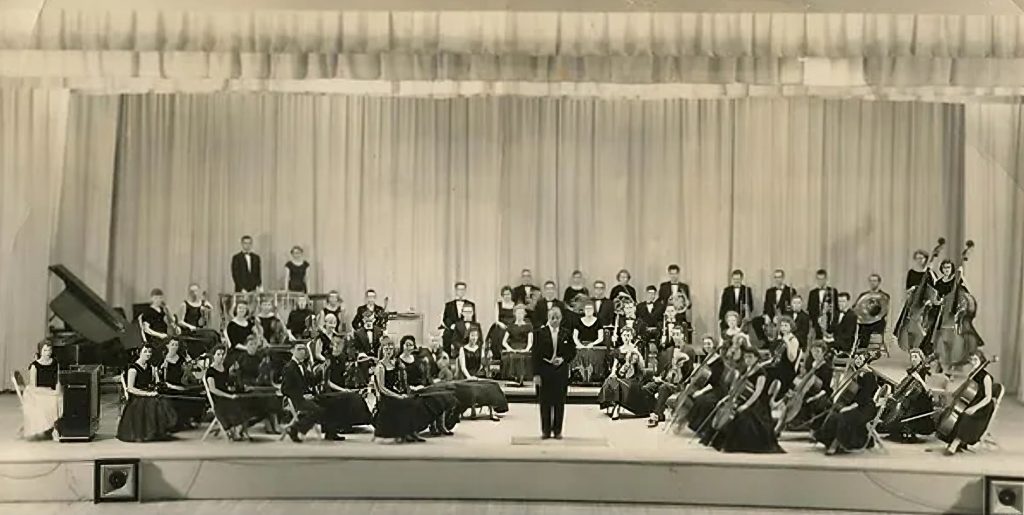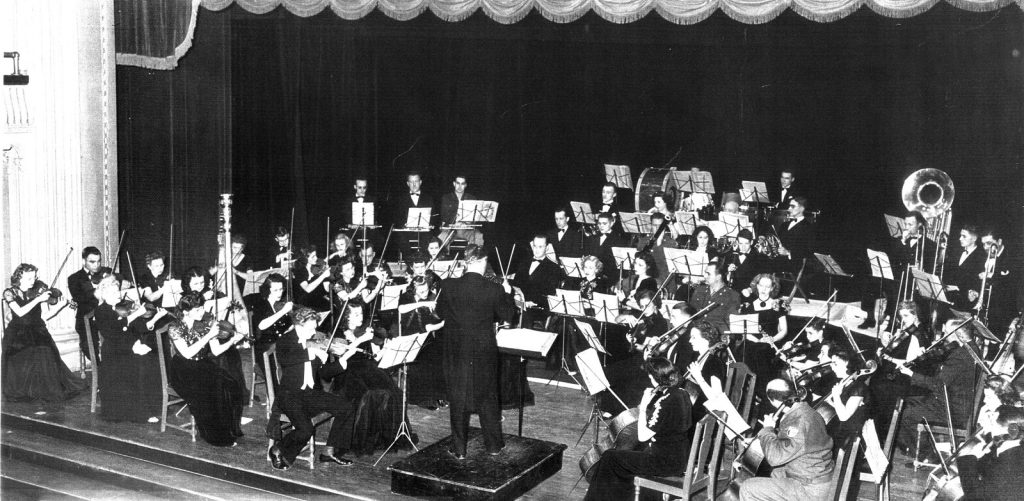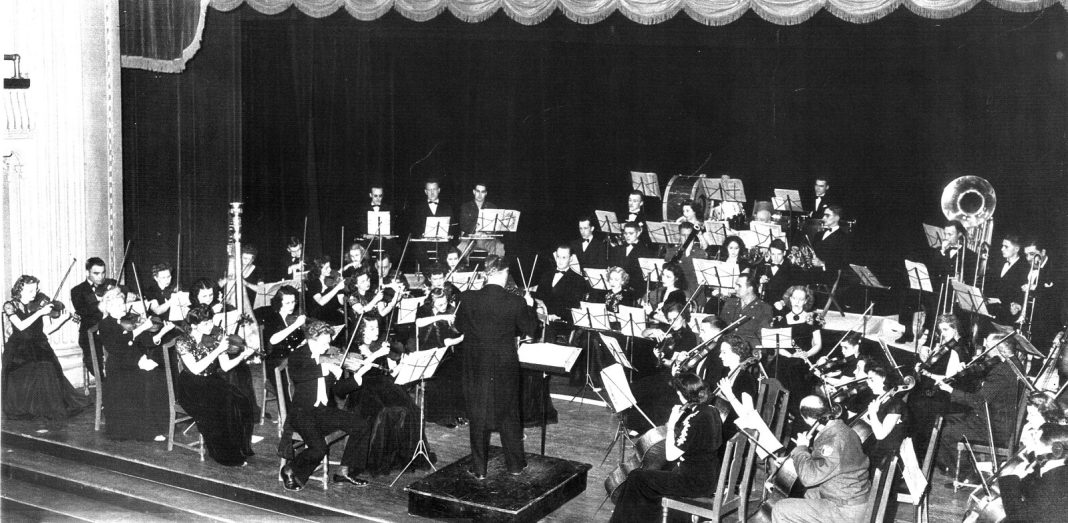A hush falls over the crowd as the stage of Spokane’s Fox Theater is illuminated in the grandest of fashion, the warm spotlight revealing the polished instruments of the city’s most prestigious ensemble. The audience lingers in quiet anticipation as the conductor raises their baton; the show is about to go on.
With a graceful sweep, the first notes break the breathless silence. As the harmonious melody rises, it erupts into a thundering crescendo reverberating through the theater in a tidal wave of sonic emotion. From its humble beginnings to its prestigious present, this cultural cornerstone has enchanted listeners with its musical trances for over 75 years; this is the magic of the Spokane Symphony, and this is their story.

The Spokane Philharmonic Orchestra Sets the Stage
Though early 20th century Spokane yearned for the grace and grandeur of its own classical music scene, a number of passionate attempts to establish a symphony orchestra would ultimately prove unsuccessful. The city’s size proved difficult to sustain an ensemble, creating financial and artistic challenges that continually thwarted these efforts, and its symphonic dreams wouldn’t be realized until 1945, when the precursor to today’s Spokane Symphony finally took the stage.
Cue Seattle Symphony violinist and concertmaster of the Tacoma Philharmonic, Harold Paul Whelan. Familiar with the city’s cultural scene through his wife and in-laws, Whelan was convinced Spokane was ripe for a professional symphony orchestra. He decided to make this dream come true after becoming a violin professor at Whitworth College, now Whitworth University. He confidently approached musicians and business leaders with his idea for a professional orchestra, but he hit a brick wall instead of finding agreeable harmony. After all, Spokane had already repeatedly tried to build an orchestra and failed miserably with each attempt, so why try again?
Still, Whelan remained undeterred as he worked to assemble a small group of musicians and supporters. In October 1945, he began rehearsing with them at the KGA radio studio, and the first mention of the Spokane Philharmonic Orchestra made headlines. Despite initial doubts and the inexperience of some musicians, he managed to form a 72-member orchestra ensemble and secure funding from an impressive group of financial patrons for his Spokane Philharmonic Orchestra Society board.

The First Years of Symphony History in Spokane
The Spokane Philharmonic Orchestra’s debut concert on December 18, 1945, at the Masonic Temple Auditorium was met with a resounding ovation. Critics praised the orchestra’s potential, hailing it as a promising addition to Spokane’s cultural landscape as the city now had the makings of a fine symphony orchestra. The orchestra’s success led to two additional well-received concerts in its debut season: a children’s concert and a traveling concert in Pullman.
The concerts became prestigious society events, with audience members dressed in formal attire. Those who missed the live concerts could hear them on KHQ radio the next day. The results were so encouraging that the board announced a second season in 1946-1947. During this time, in the fall of 1946, the concerts were also switched to the Post Street Theater, a 1,174-seat downtown movie house, with performances held on Mondays.
Despite a nationwide broadcast on NBC Radio’s Pioneers of Music series in 1950, the orchestra struggled financially. It became apparent that ticket sales alone couldn’t cover the costs of paying musicians, rent, publicity, and insurance. In 1951, the board president reported that the organization was barely staying afloat as generous donations became vital to its survival. Just as quickly as the Spokane Philharmonic Orchestra’s melody had commenced, these early challenges threatened to swiftly silence its symphony.
Community Support Temporarily Saves the Spokane Symphony
The community quickly rallied to support the orchestra as a response to the news. A new Women’s Auxiliary, later renamed the Spokane Symphony Associates, held successful fundraisers and provided free office help and ticket-selling services. The orchestra’s artistic status, as opposed to its financial condition, was higher than ever. When the city staged the grand opening of the Spokane Coliseum on December 3, 1954, the Spokane Philharmonic was selected to co-star the event along with homegrown Metropolitan Opera soprano Patrice Munsel before a crowd of 8,000.
Yet, even as the Spokane Philharmonic reached new heights, the orchestra’s future remained uncertain as it moved from its Post Street Theater home to the larger Fox Theater. By 1960, the Spokane Philharmonic Orchestra was again in crisis as it struggled to sell out shows at the 2,300-seat venue.
In early 1961, tensions arose within the board regarding the perceived quality of Whelan’s leadership, leading to a vote that narrowly retained him as the 32-person board found itself split between pro-Whelan and anti-Whelan members. After winning by one vote, Whelan became angered by the close outcome of the results and resigned shortly after. Despite his resignation, the anti-Whelan board members also resigned, leaving only the pro-Whelan faction. A final meeting was held amongst the remaining members, resulting in the dissolution of the Spokane Philharmonic Orchestra so that they could begin anew as the Spokane Symphony.

Turning the Disharmony into the Spokane Symphony
On March 20, 1961, the show was scheduled to go on, but instead, the Spokane Philharmonic Orchestra officially dissolved, giving rise to the Spokane Symphony. In essence, the new organization was a continuation of the old, retaining most original musicians, including Whelan as the conductor.
On the evening of April 3, an eager crowd of over 1,000 gathered again at the Post Street Theater to listen as the Spokane Symphony played its first chord under its new name. The reorganization revitalized the orchestra, which successfully paid off its debts. It seemed as if the orchestra had finally found its harmony. Yet, a dissonant note would have the ensemble questioning everything again when Whelan announced his departure in April of 1962, taking a faculty job at Alameda State College in California. He conducted his final Spokane concert a month later, in May.

A New Era for the Spokane Symphony
Donald Thulean, a talented conductor, was hired to replace Whelan, ushering in a period of artistic growth and financial stability for the Spokane Symphony as he proved successful in doubling the number of annual classic concerts to ten and launched a Concerts for Youth series. Between 1964 and 1965, attendance levels would make it the most successful season yet, prompting the board to offer Thulean a three-year contract as music director. In his new role, he expanded the symphony by initiating a touring program, launched a series of opera performances by partnering with the Seattle Opera Association, and introduced a series of pops concerts, which quickly became a staple of the symphony’s season before eventually being made into a separate series.
When the symphony lost its Post Street Theater home again in 1968 and returned to the Fox Theater in October, it was a mixture of emotion as the venue’s past struggles with filling seats bubbling to the surface. Thankfully, this time was different as the orchestra had finally found its rhythm and audiences continued to grow alongside the symphony’s artistic reach, allowing it to present many world-class guest artists in the early 1970s.
Finally, in 1974, the Spokane Symphony would receive its biggest opportunity yet, marking Spokane’s history with a leading role on the historic Expo ’74’s entertainment calendar, playing 20 concerts for the fair, including the first one to kick off the event and last concert to conclude the festivities. To accommodate the performances, Expo ’74 gifted the Spokane Symphony a new concert hall, the Spokane Opera House, now the First Interstate Center for the Arts. Following its unveiling, the orchestra experienced what it called the “Expo Bump,” boosting both attention and attendance that would carry the symphony through the next several years.
Through the decades, the journey of the Spokane Symphony has played out like a masterful composition, each movement marked by the resilience to overcome and the triumphs that followed. The success of Expo ’74 wouldn’t last forever, as the orchestra once again faced financial crises, labor disputes, and housing issues. Still, despite the dissonance of setbacks, the Spokane Symphony continued to find its harmony as it flourished into the city’s largest cultural institution and one of the most renowned symphonic orchestras in the United States.








































